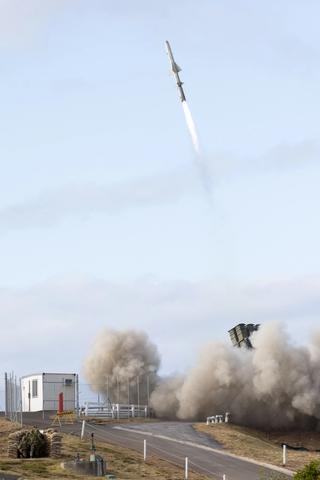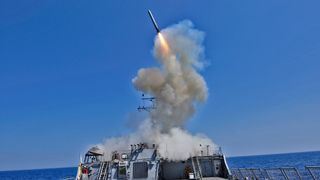In December 2022, the Japanese government released a trio of major strategic documents—the National Security Strategy, the National Defense Strategy, and Defense Buildup Program. As part of this review of Japan’s national security settings, Japan acquired long-range strike capabilities that the Self-Defense Forces (SDF) have not previously possess, assets which the Japanese government refers to as "counterstrike capabilities.”
On the face of it, the mere political commitment to acquire these capabilities was significant. Indeed, for a long time, constitutional restrictions, political norms, and a relatively benign strategic environment meant that Japan could afford to demur on the SDF’s power projection capability, even when assets like the Air Self-Defense Force (ASDF) F-2 fighter plane could be equipped with guided strike munitions like the Joint Direct Attack Munition (JDAM). However, various other components needed in a mission package to penetrate deep into enemy territory and conduct strike operations were lacking. For example, the ASDF lacked escort jammers such as the EA-18G, while the number of aerial tankers required to expand the range and persistence of Japanese fighter options was also limited. Furthermore, what strike capabilities Japan did possess were limited in range. For instance, the Ground Self-Defense Force had not procured ground-based long-range missiles, with its longest-range land-based missile, the Type 12 surface-to-ship missile, limited to a range of approximately 200 km.
However, in recent years the Japanese government has gradually introduced longer-range strike weapons, even before the 2022 updates to its national defence policy settings. In 2018, it acquired joint strike missiles for the F-35 and JASSM-ER for the F-15 with a range of between 900 and 1900 kilometres. It is in that context that Japan is now considering longer-range strike options to augment its deterrence capabilities. Among the capabilities flagged for acquisition with the release of Japan’s new security documents in December 2022, were the 400-round Tomahawk and a domestically developed cruise missile called the Improved Type 12, as well as Hyper Velocity Glide Projectile (HVGP) and hypersonic cruise missiles (HCM) still in development. Initially, these systems have been described as “inter-island long-range fire systems for remote island defense” – in other words, capabilities for standoff attacks against enemies invading Japanese territory or territorial waters. However, speculation remains about whether these missiles could, at least in theory, also be used for preemptive strikes against targets outside of Japanese territories, given that the range of the Tomahawk and improved Type 12s is said to exceed 900 and 1600 kilometres, respectively. In particular, the HVGP Block 2B can be regarded as having similar capabilities to the Long-Range Hypersonic Weapon (LRHW or Dark Eagle) being developed by the US Army. This means that regardless of Japan’s public position on the use of these systems, they nevertheless have the technical capability for deep precision strikes against targets on the Chinese and North Korean main lands.
As part of the acquisition process, the Ministry of Defense conducted wargames based on multiple defence planning scenarios to identify capability gaps within the SDF. However, it is worth remembering that the SDF would be unlikely to fight alone in situations requiring the use of counterstrike weaponry. Indeed, to use these strike assets effectively, Japan will need to engage with the United States and other key partners – particularly South Korea and Taiwan – on a range of requirements, including establishing common and well-defined theories of victory, developing a joint and/or combined operational concept, shared targeting doctrine, and joint targeting coordination cycle. Yet, whereas the acquisition of these weapon systems was decided upon earlier, these critical operational concepts and doctrines remain well and truly in the development phase.
The problem with “counterstrike”
A key issue is the unique and somewhat ambiguous term “counterstrike”, and the priority that this term seemingly places on ‘deterrence by punishment.’ Given that Japan’s strike capabilities are or will all be conventionally-armed missile systems (given Japan’s lack of nuclear weapons), this will naturally place limits on the parameters of Japan’s targeting doctrine. Even with significant advances in Japan’s own intelligence, surveillance, reconnaissance, and targeting (ISRT) capabilities and precision guidance technology, effective deterrence by conventional forces against a nuclear-armed adversary such as China or North Korea will be difficult to accomplish – especially if Japan is responding to a nuclear strike.
There are several reasons why a strategy premised on punishment would be problematic for Japan. First, for Japan to launch a counter-value strike using conventional forces comparable to the lethality of nuclear weapons, would require a tremendous number of munitions and launching platforms alike. It is impossible for the SDF, which even now faces critical munitions shortages, to acquire and deploy such munitions stockpiles and launchers in a short period of time. Second, even without possessing or using nuclear weapons, Japan has effectively ruled itself out of adopting the countervalue option. For example, the 2023 Defense White paper’s discussion on Japan’s self-defence capability development cites the outcomes of Diet deliberations which concluded that Japan was not legally permitted to possess intercontinental ballistic missiles (ICBMs), attack aircraft carriers, or strategic bombers, all essential means of holding distant high-value targets at risk. Crucially, the essence of this position is that Japan is prohibited from possessing “offensive weapons” designed primarily for the mass destruction of another country.” This, in effect, rules out the adoption of the counter-value strike doctrine based on the delivery of highly destructive strikes against urban areas, the sort that Japan’s nuclear-armed neighbours are already capable of threatening, reflecting the complexities and reluctant nature of Japan’s emerging strike targeting doctrine. Needless to say, the countervalue option should not be employed, even if it is by conventional forces.
Even with significant advances in Japan’s own intelligence, surveillance, reconnaissance, and targeting capabilities and precision guidance technology, effective deterrence against a nuclear-armed adversary such as China or North Korea will be difficult to accomplish.
Third, strike operations that would put high-value targets, such as adversary leadership, at risk would also be difficult to conduct with conventional forces. Though the United Sates has conducted several special operations targeting high-value leadership targets, such as al-Qaeda’s Osama bin Laden and Iran’s Qassam Soleimani, intelligence on these targets was not continuously available on a 24/7 basis. Japan (and the United States) would face similar challenges in tracking the activities of Chinese or North Korean leadership, particularly given Japan’s well-established intelligence-gathering challenges. Vague threats that target-killing may be possible only if certain conditions are met are not sufficient to deter aggressive decisions by these political leaders. Fourth, prospective Japanese strike operations to punish or retaliate against aggression against the homeland are unlikely to be decisive in ending a conflict; they are most likely to be one phase in a chain of escalation. In considering escalation control, even if Japan were to launch a retaliatory strike, it must assume a renewed counterattack from its adversary. In this regard, since it would be near-impossible to eliminate all Chinese and North Korean strike capabilities with Japan’s conventional capabilities alone, Beijing and/or Pyongyang would be free to retaliate against Japan, including with nuclear weapons, if Japan retaliates against their initial strikes in a punitive manner.
Granted, such further action may be deterred by an extended deterrence commitment by the United States to Japan. Yet to make this credible, it is necessary to signal to the adversary that the US commitment is assured at the stage of the initial punitive retaliation in the first place. If this is the case, then the scale of retaliation is not a meaningful indicator in determining the most appropriate quality and quantity of Japan’s counterstrike capability since any proportional response of any kind should be implemented jointly with the United States from the outset. Thus, Japan’s limited conventional strike capability cannot and should not be a credible deterrence by punishment.

Counterstrike for denial
Given these considerations, it is clear that a doctrine for Japan’s counterstrike capability should be premised on a long-range, conventional counter-force capability for denial operations. In that case, what should be the ultimate goal for the development of Japan’s strike capability, and what should it be designed to target? The challenge is that there is a difference between the technical and political difficulty required to conduct strike operations.
Considering the technological capabilities that the Japanese defence industry has built up over the years, extending the range of existing missiles is not that difficult. It has already been confirmed that the current model of Type-12, which uses a turbojet engine, will be upgraded through the integration of a more fuel-efficient turbofan engine, the same method used to extend the range of the US JASSM. Meanwhile, the solid rocket motor technology that will be used for the HVGP has already been developed for various satellite launch vehicles. In addition, Japan has already confirmed the purchase of 400 US-built Tomahawk missiles with a range of up to 1600 kilometres. In addition, the Japanese government already has several intelligence-gathering satellites and many commercial imaging satellites available, meaning that Tokyo will likely have developed the means to conduct deliberative targeting against fixed targets before 2027.
However, there are technical hurdles to long-range strikes against maritime moving targets. Existing Type 12s, which have a range of about 200 kilometres, track their targets by an inertial navigation system (INS) with mid-course GPS guidance and active radar homing. However, an improved Type 12 with a range of 900 kilometres or more would require a data link to update target data after launch, on top of its existing guidance system. This will be a one-way data link from a ground launch station to the missile via a relay satellite, to update missile flight and targeting data. The development and implementation of these technologies is already included in the Type 12 upgrading program, but further technological development is required to extend the range of the Type 12 to more than 1600 kilometres or to enable real-time and adaptable targeting of ground-based mobile targets such as transporter erector launchers (TELs). For example, it is impossible to immediately engage a road-mobile missile like the Chinese DF-21 or North Korean No-dong, which can change positions in 15 to 20 minutes, with a subsonic cruise missile. At present, Japan has no plans to develop a strike package like the US Joint Force, which combines small numbers of intrusive fighter-attackers with precision-guided munitions like the JDAM or JSOW, along with an escort jammer like the EA-18G ‘Growler’. Granted, although Japan’s Acquisition, Technology & Logistics Agency (ATLA) has begun research and prototyping for the electronic warfare technology that could lead to the development of a stand-in jammer aircraft, this is not expected to be viable before 2028 at the earliest once ATLA completes research for other relevant technologies. Therefore, if dynamic targeting against time-sensitive targets using long-range missiles is to be effective, Japan’s missiles must be equipped with a two-way data link, like the JASSM-ER, so that the operator can direct a change of target based on information from the missile, especially if these munitions are to be capable of loitering in an operational area where mobile targets may be hiding.
In addition, there is the question of ordinance payloads. As it stands, the warhead for the Type-12, originally developed for ship-attack missions, cannot effectively damage runways or hardened bunkers. If the intention is to develop the means for efficient mission-killing of adversaries’ air base networks, submunition (anti-aircraft mine) dispensers or cluster warheads for cruise missiles would be needed to degrade or outright prevent combat sorties by enemy fighters and bombers, with the added requirement of complying with the Convention of Cluster Munitions, a treaty which Japan has ratified. In addition, an attack on a hardened bunker would require a high-impact resistant warhead (the Japanese version of Joint Multi-Effect Warhead System or JMEWS), for which the Japan Ministry of Defense commenced technical development in FY2023. Given the lethality limitations of such cruise missiles, strike operations against fixed hard targets would be most efficient with HVGPs or medium-range ballistic missiles. More to the point, if Chinese and North Korean air defence capabilities improve, these cruise missiles are likely to be met with a variety of countermeasures. In addition to acquiring cruise missiles, it would be necessary to acquire electronic warfare decoys capable of emulating the electronic signature of strike aircraft, which could then be launched from a variety of platforms, including unmanned aerial vehicles, destroyers, and transport aircraft to deceive adversaries’ air defences.
In summary, on a sliding scale of technical difficulty, targeting and striking fixed soft targets would be the easiest, followed by fixed hard targets or moving maritime targets, with the most difficult being ground-based time-sensitive targets. Yet, political factors will further complicate these calculations. Though ship attack operations have long been a part of the SDF's mission, Japanese political leaders have until now not had to make decisions about deep strike operations against China or North Korea – let alone considering what kinds of escalation might occur as a result of such decisions, or broaching these issues in the public domain. This lack of decision-making experience may create a psychological barrier for Japanese political leaders and cause them to hesitate to launch deep strike operations, even if they are effective from a military perspective, in the event of a crisis.
This dilemma is not unique to Japanese political leaders. Just as the Biden administration has long hesitated to provide Ukraine with weapons such as the army tactical missile system (ATACMS) and F-16 fighter jets that could be used to deep-strike into Russian territory, the policy community in Washington DC, may also be hesitant to conduct deep strikes into mainland China in the event of a crisis for concern of further escalation. However, if a deep strike option against mainland China is on the table, Taiwan, Okinawa, and even mainland Japan would likely have already been attacked by China, and counterstrike operations exactly already be under consideration. If US political leaders still hesitated to strike back mainland China under such circumstances, the credibility of US extended deterrence guarantees to Japan would be severely undermined.
Decision-making regarding deep strike operations will depend not only on the political leadership, but also on the command and control structures available to military leaders.
Decision-making regarding deep strike operations will depend not only on the political leadership, but also on the command and control (C2) structures available to military leaders. Although SDF intelligence officers may have experience in collecting and analysing broad intelligence on ground targets, the training of commanders capable of managing dynamic joint targeting cycles and targeting officers who can create specific target sets, organically combine limited assets, and prioritize them for conducting strike operations has only just begun. From Operation Desert Storm, through Operation Allied Force and Operation Enduring Freedom, it has taken the US forces more than a decade to be able to implement full-spectrum dynamic targeting in Operation Iraqi Freedom. For Japan to transform its command-and-control process to combine high-level political decision making with joint-level targeting cycles in the SDF in a timely fashion, collaboration with the United States will be essential, but will also present a major challenge in terms of thinking through joint warfighting requirements. In this regard, there is much to be learned from how the US-South Korea alliance shares roles, missions, and capabilities, and from the example of combined targeting coordination in the US-Korea Combined Forces Command. All considered, it would seem that political decisions for Japan regarding potential strike operations will be relatively easier to make regarding maritime targets, and much more difficult for ground targets.
Thinking through requirements
How to balance this technical and political difficulty is a challenging matter, and the answer to these dilemmas may not be apparent at the outset. What is clear, however, is that much thinking remains to be done regarding the procurement of Japan’s strike weapons and how these will fit into joint and combined planning with the United States. A good first step would be to build greater mutual confidence and understanding between Japanese and US military planners through a series of table-top exercises focusing on strike operations and escalation control, with high-level political support from both the US and Japanese governments.
Secondly, Japan will need to think through the most appropriate timeframe between force planning and actually deploying its strike assets. Indeed, time is already short. As the official reports of both the US and Japanese governments suggest, China and North Korea are developing theatre-range strike capabilities are a pace that currently outstrips the allies’ efforts to bolster their own defensive resources and develop deep precision strike capabilities. To close this gap, the Japanese government will need to conduct joint capability assessments and analyses with the United States based on common defence planning scenarios. Both countries will also need to build an integrated logistics and battle management network capable of sharing real-time data on how much ammunition each country has in stock, and where it is located. This is an urgent task given the growing demand for US long-range precision-guided munitions, not only from frontline allies in the Indo-Pacific, but also in other regional theatres, particularly Europe and the Middle East.
Such analyses should be used to identify delays in development, acquisition, deployment plans, and production at an early stage, in the interests of implementing supplemental measures in a timely manner. Indeed, there have already been delays to Japan’s acquisition of JSMs and JASSM-ERs. Similar problems may occur in the Tomahawk acquisition and its mission system integration. In fact, the Ministry of Defense has decided to modify its original plan to acquire 400 of the newest version Tomahawk Block 5s in favor of acquiring 200 Block 4s (the current version, which has no anti-ship attack capability) ahead of schedule, in order to prioritise the field deployment of Tomahawks over a shorter timeframe and to offset concerns over production timelines and bottlenecks. Alternatively, if there are delays in the development and deployment of the improved Type 12, it may be necessary to consider deploying the ground-based Tomahawks being developed by the US Marine Corps and Army to Japan through rotational exercises and other means. The deployment of the HVGP would also be later than the timing of the deployment of the US LRHW, even if development proceeds as planned. In this regard, Japan and the United States should also begin to consider options for hosting US LRHW, capabilities in Japan. For example, additional munitions depots and support facilities could be constructed for dispersed deployment at several JGSDF maneuver areas located in Kyushu, Honshu, and Hokkaido. In addition, the US Army should consider inviting the JGSDF long-range missile units to participate in LRHW maneuver deployment training.

Thirdly, the US-Japan alliance and their mutual partners should work together to consider further diversifying cost-effective maritime strike options. The long-range strike systems that Japan is developing and acquiring are all expensive and have limited production capacity. As highlighted by recent wargaming, US manufactured long-range precision-guided munitions such as the JASSM-ER and LRASM (Long Range Anti-Ship Missile) also have similar problems in terms of low production and stockpiles. From this perspective, it would be useful to develop low-cost strike options that effectively integrate existing affordable munitions and technologies, such as the Ground Launched Small Diameter Bomb (GLSDB), which the United States has begun to provide to Ukraine. Such work is already in motion in other domains. For example, the US Air Force is developing an anti-ship guided munition called "Quicksink," which adds ship-attack capability to the existing JDAM. Boeing is also developing an integrated kit consisting of a small jet engine and wing that will enable JDAM to extend its range to over 550 kilometers. If these technologies could be applied to diversify low-cost anti-ship options capable of being launched from the ground or from a surface vessel, it might be possible to close the quantitative missile gap with China. It will also be essential to acquire multi-role stealth UAVs such as the XQ-58, which can emulate the electronic signatures of attack aircraft, to increase the success rate of attacks by what will remain a relatively small number of expensive cruise missiles.
It is now almost unfamiliar to hear criticism that Japan's own long-range strike capability would undermine regional stability, with only opposition political parties, progressive media, and civil society groups persisting with such narratives in Japan. Such claims would only have validity if China and North Korea did not already possess such capabilities. In reality, they possess far more theatre strike capabilities than Japan, and many of these systems are potentially dual-capable (that is, capable of carrying conventional or nuclear warheads). This asymmetry in theatre strike capabilities provides a "window of opportunity" for them to challenge the rules-based regional order. If the window of opportunity is already opening for China and North Korea, Japan's long-range strike capability will, rather than destabilising the region, prove to be a stabilising force.






